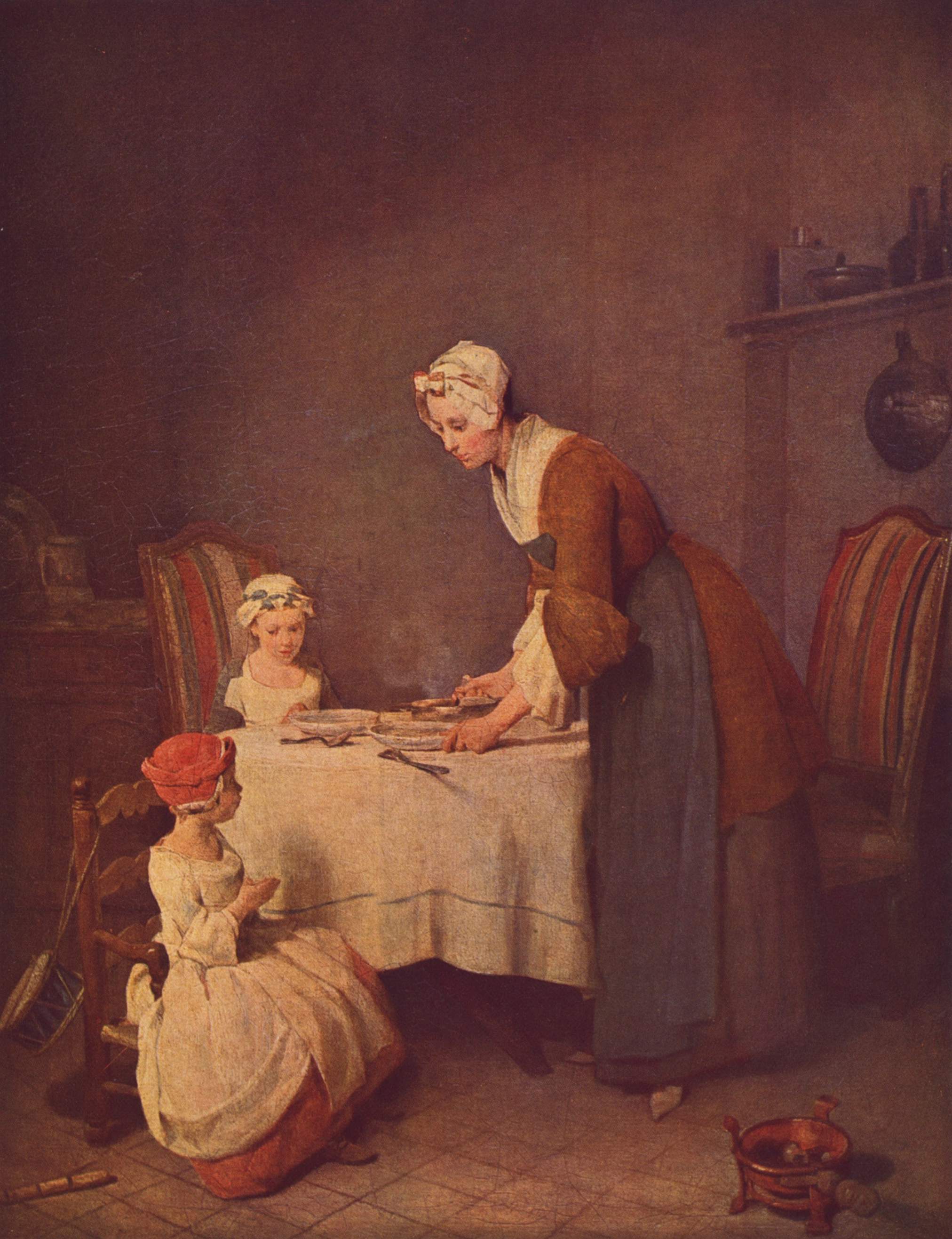- Le Bénédicité
Infobox Painting

title=Le Bénédicité
artist=Jean-Baptiste-Siméon Chardin
year=c. 1790
type=Oil on canvas
height=49.5
width=38.5
height_inch=19.5
width_inch =15.2
city=Paris
museum=Louvre "Le Bénédicité" (Lang-en|"Grace") is a painting by the French artist
Jean-Baptiste-Siméon Chardin . Chardin made several versions of the painting, one of which was given as a gift to Louis XV. The subject of the painting is one of bourgeois, everyday tranquillity – Chardin's field of expertise, with an uncharacteristic touch of sentimentality.History
Chardin, who had made his fame painting
still life , had at this point in his career started also to include human figures in his works. [Rosenberg, p. 12.] He painted several versions of "Le Bénédicité", three of which were exhibited at the Salon, in 1740, 1746 and 1761.Rand and Bianco, p. 128.] The original, from 1740, was given as a gift to the King. [Hyland, p. 271.] The painting fell into oblivion ten years after the death of Louis XV, but was rediscovered in 1845.fr icon cite web | url = http://www.lemondedesarts.com/Dossierchardin.htm | title = Jean-Baptiste-Siméon Chardin (1699-1779) | publisher = "Le monde des arts" | author = | date = | accessdate = 2008-02-18] Another version was kept by the artist throughout his life, and eventually ended up in theMusée du Louvre , through the large bequest ofLouis La Caze in 1869. [cite web|url=http://www.louvre.org/llv/exposition/detail_exposition.jsp?CONTENT%3C%3Ecnt_id=10134198673469921&CURRENT_LLV_EXPO%3C%3Ecnt_id=10134198673469921&pageId=2&bmLocale=en|title=The La Caze Collection|publisher=Musée du Louvre|author=|date=|accessdate=2008-03-05] The version from the 1761 Salon – a horizontal composition – is now lost.The painting
Chardin is well known for his depictions of humble, everyday life.Gombrich, p. 470] "Le Bénédicité" shows a modest, middle-class interior scene, where a mother is laying the table for a meal. She instructs her children – a young boy and his slightly older sister – to say their grace before eating. The younger of the children can easily appear a girl to the modern eye, if the drum hanging on the child-sized ladderback chair is overlooked, [The drum is as iconic a boy's toy in depictions of children as a doll is a girl's. Boys were in petticoats and dresses until they were "breeched" at about the age of six.] and is indeed identified as such in Gardner. [Gardner, p. 640] Rand and Bianco, however, quote the inscription on a contemporary engraving, describing the child as a boy, [Rand and Bianco, p. 128] who has not yet been breeched. The quiet, peaceful atmosphere is reinforced by the subdued colour scheme, and the muted lighting.Gardner, p. 640.] Chardin put much work into the arrangement of the various elements of his paintings. The composition here is meticulous, and the stability created by the triangular structure of the three figures also adds to the tranquillity of the scene.
Reception
Chardin is often contrasted to Watteau, whose paintings of aristocratic life differ greatly from those of Chardin's common people. It is not known for certain whether "Le Bénédicité" was painted with Louis XV in mind, or if it was the king who personally picked the painting out from the 1740 exhibition. In either case, the purchase shows the appeal the painting had to its contemporaries. When it was rediscovered in 1845 – on the eve of the
revolutions of 1848 – it had taken on a whole new meaning. To the bourgeois establishment, the works of Chardin now represented a salutary contrast to the decadent aristocratic flimsy of Watteau. In 1848, an anonymous reviewer in the journal "Magasin Pittoresque" wrote:References
ources
*cite book | first = Helen | last = Gardner | authorlink = | title =
Gardner's Art Through the Ages | edition = 9th ed. | publisher = Harcourt Brace Jovanovich | location = San Diego | year = 1991 | id = ISBN 0155037692 | url =
*Gombrich, E.H. (1995), "The Story of Art", 16th ed. London & New York, ISBN 071483355X
*Hyland, Paul (ed.) (2003), "The Enlightenment: A Sourcebook and Reader" London: Routledge, ISBN 0415204488
*Rand, Richard & Juliette M. Bianco (1997), "Intimate Encounters: Love and Domesticity in Eighteenth-Century France", Princeton, N.J.:Princeton University Press, ISBN 0691016623
*Rosenberg, Pierre (2000), "Chardin", Munich and London: Prestel ISBN 3791323393External links
* [http://www.louvre.org/llv/oeuvres/detail_notice.jsp?CONTENT%3C%3Ecnt_id=10134198673225125&CURRENT_LLV_NOTICE%3C%3Ecnt_id=10134198673225125&FOLDER%3C%3Efolder_id=9852723696500815&bmLocale=en Information] about the painting at the
Musée du Louvre web site.
*fr icon [http://www.lemondedesarts.com/Dossierchardin.htm Information] about the painting on " [http://www.lemondedesarts.com/ Le monde des arts] ".
Wikimedia Foundation. 2010.
